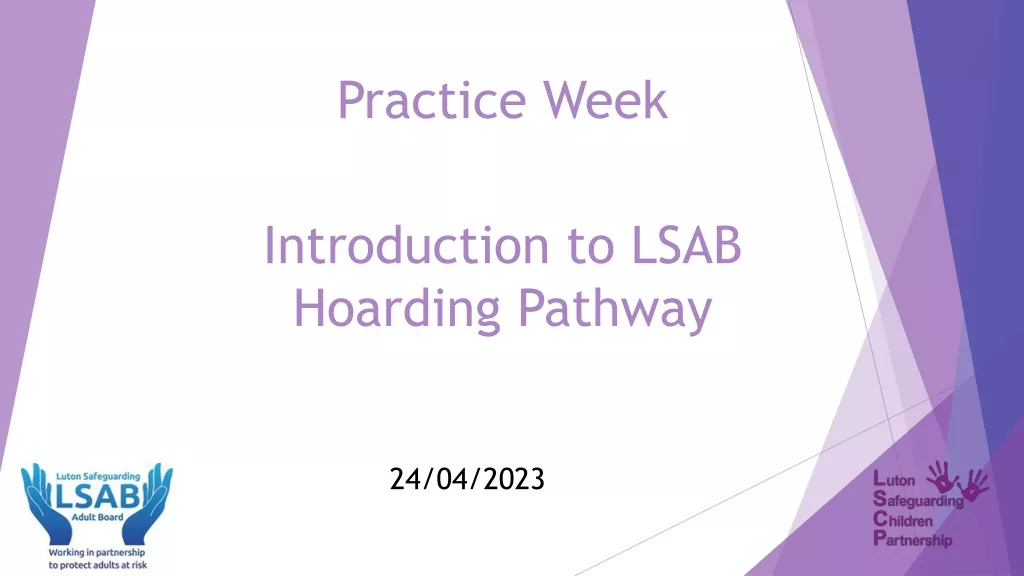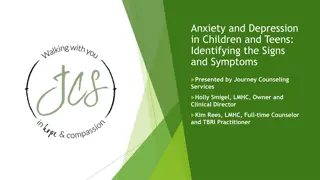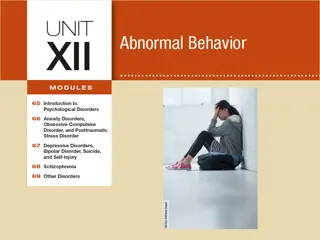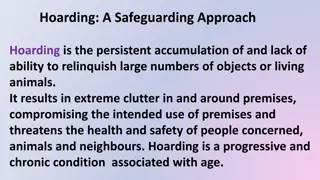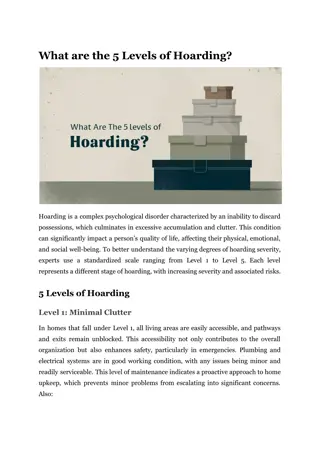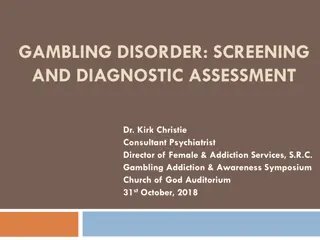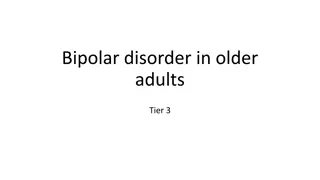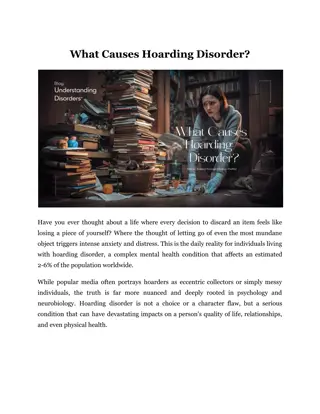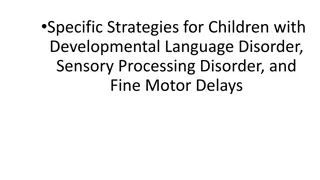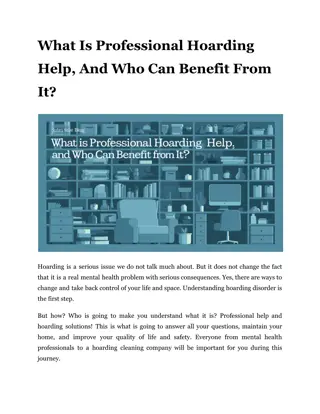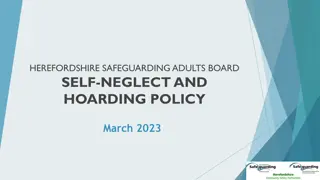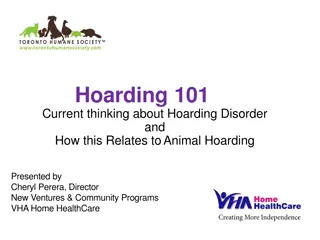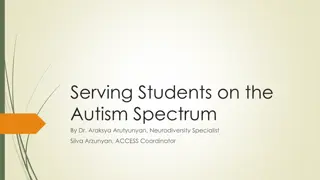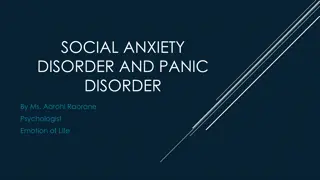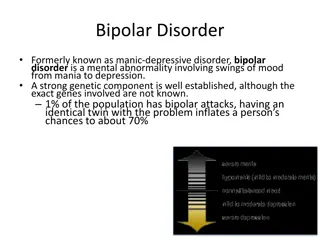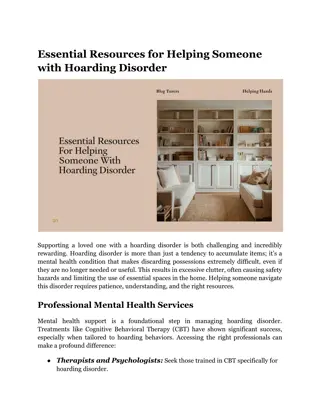Identifying Hoarding Disorder Criteria
"Learn about the diagnostic criteria for identifying hoarding disorder, including persistent difficulty discarding possessions, distress associated with discarding items, clutter accumulation, functional impairment, and exclusion of other medical or mental conditions. Explore how hoarding can be linked to various physical and mental health issues, such as dementia, depression, schizophrenia, and OCD. Understand the complexities of hoarding behavior and its impact on individuals' lives."
Download Presentation

Please find below an Image/Link to download the presentation.
The content on the website is provided AS IS for your information and personal use only. It may not be sold, licensed, or shared on other websites without obtaining consent from the author.If you encounter any issues during the download, it is possible that the publisher has removed the file from their server.
You are allowed to download the files provided on this website for personal or commercial use, subject to the condition that they are used lawfully. All files are the property of their respective owners.
The content on the website is provided AS IS for your information and personal use only. It may not be sold, licensed, or shared on other websites without obtaining consent from the author.
E N D
Presentation Transcript
Understanding Hoarding Jack Moore FCIH, Hannah Scott, Fraser MacKinnon www.frontlinenetwork.org.uk/funding
Hoarding or Extreme Clutter? www.frontlinenetwork.org.uk/funding
Hoarding or Extreme Clutter, as a result of, or resulting in Depression Anxiety Obsessive-compulsive disorder Hoarding disorder Phobias Psychosis Bipolar disorder Schizophrenia Eating disorders Dementia N eurodiver sity ADD/ADHD Dyscalculia Dyslexia Dyspraxia Developmental co- ordination disorder (DCD Tourette s Syndrome Autism / Autistic Spectrum Asperger s Syndrome www.frontlinenetwork.org.uk/funding
The five diagnostic criteria used to identify a case of hoarding disorder 1. Persistent difficulty discarding or parting with possessions, regardless of their monetary value 2. This difficulty is due to a perceived need to save the items and distress associated with discarding them 3. The difficulty discarding possessions results in the accumulation of possessions that congest and clutter active living areas 4. The hoarding causes clinically significant distress or impairment in social, occupational, or other important areas of functioning 5. The hoarding is not attributable to another medical condition or mental disorder www.frontlinenetwork.org.uk/funding
Hoarding can also result from other problems Physical illness can lead to tiredness and disorganisation. Dementia memory problems can interfere with someone s ability to organise themselves and their belongings. Depression can make you lose interest in your normal activities, make it hard to concentrate and make it hard to make decisions. Alcohol and drug misuse can affect your ability to look after yourself. Schizophrenia unusual beliefs and a lack of organisation can lead to hoarding. Bipolar disorder can make you shop too much (highs), and will interfere with your organisation (lows). Learning disability or acquired brain injury can lead to problems with thinking and memory. www.frontlinenetwork.org.uk/funding
Hoarding can also result from other problems (contd) Autism and related disorders collecting things can be a source of comfort. (clear communication / step by step actions / bite-sized interventions) Obsessive Compulsive Disorder (OCD) you don't feel attached to your hoarded items, but you do fear what will happen if you throw them away, or fear of contamination results in inability to tackle post or throw rotten food away. About 1 in 20 people with OCD have a problem with hoarding. (NB Other research 20-30%) (Royal College of Psychiatrists) Attention deficit (and hyperactive) disorder trouble staying focused on one task, flit from one area of interest to another PTSD or Victim of Crime creates barrier or buffer against further disaster Struggling to cope with a stressful life event, such as bereavement or redundancy Excessive guilt about waste www.frontlinenetwork.org.uk/funding
Risk factors Increased risk of Fire Accumulation of combustible materials such as newspapers, clothing and rubbish (stats; 1 in 4 and 90%/40%) Structural Damage Structural damage threatens the occupants, public safety personnel and adjacent buildings Disease, Injury and Infestation Storage of hoarded items makes cleaning nearly impossible, which can lead to unsanitary living conditions and increases the risk of disease Avalanche www.frontlinenetwork.org.uk/funding
Our dehoarding service Referral Initial visit Quote Visits commence Working sheets Progress meeting Ongoing support / monitoring www.frontlinenetwork.org.uk/funding
Empathy and understanding Work in pairs Hands-on service Tipper / van if or when required Typical case 3 hours per week for 3 months 85% success rate (in achieving goal) Our PLUS Hospital Discharge Service Regional Hoarding Support Groups www.frontlinenetwork.org.uk/funding
P3s Hoarding Support Services www.frontlinenetwork.org.uk/funding
Services in 17 Counties 53 local district and boroughs Currently we run hoarding services in Derbyshire, Warwickshire, Buckinghamshire and Redditch P3 have provided housing-related support services since 1972 We deliver support to 9000 individuals at any- onetime and over 33,000 people annually.
P3 Hoarding services in-home practical support Emotional/Psychological Support
Collaborative Approach: Working Together Understand that building trust takes time On average we will work with someone for just under 1 year Building support into weekly routine Move at a pace that works Motivational techniques
Collaborative Approach: Working Together Motivational techniques Set Small goals that help break down large barriers Discuss the different ways to assign value Help to find systems that work for the life someone wants to live Address buying habits and meaningful use of time
Q&A Opportunity now for you to put your hoarding related questions and observations to Jack, Hannah and Fraser


